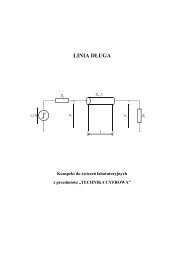9 Interlayer Exchange Interactions in Magnetic Multilayers
9 Interlayer Exchange Interactions in Magnetic Multilayers
9 Interlayer Exchange Interactions in Magnetic Multilayers
You also want an ePaper? Increase the reach of your titles
YUMPU automatically turns print PDFs into web optimized ePapers that Google loves.
330 9 <strong>Interlayer</strong> <strong>Exchange</strong> <strong>Interactions</strong> <strong>in</strong> <strong>Magnetic</strong> <strong>Multilayers</strong><br />
netic layers. Historically, this type of <strong>in</strong>teraction was first proposed by Ruderman<br />
and Kittel to describe the <strong>in</strong>direct <strong>in</strong>teractions between nuclear sp<strong>in</strong>s <strong>in</strong> a metal<br />
[2], and then extended to electronic magnetic moments by Kasuya [3] and Yosida<br />
[4]. This <strong>in</strong>teraction has received a much attention, <strong>in</strong> particular <strong>in</strong> the context of<br />
dilute magnetic alloys. Neither theoretical predictions, nor the experiment results,<br />
were, however, sufficiently precise to enable fully understand<strong>in</strong>g of this mechanism<br />
and quantitative test<strong>in</strong>g of the theoretical predictions. Indirect exchange <strong>in</strong>teractions<br />
have received <strong>in</strong>tensly renewed attention s<strong>in</strong>ce 1990 <strong>in</strong> the context of magnetic multilayers<br />
– <strong>in</strong>deed, <strong>in</strong> contrast with the situation of a dilute alloy, <strong>in</strong> which the distance<br />
between magnetic impurities is randomly distributed, multilayers enable controlled<br />
variation of the distance between successive magnetic layers and their crystallographic<br />
orientation; this enables a very detailled study of <strong>in</strong>direct exchange <strong>in</strong>teractions.<br />
In this chapter we present an overview of the state-of-the-art of our understand<strong>in</strong>g<br />
of <strong>in</strong>terlayer coupl<strong>in</strong>g as a result of <strong>in</strong>direct exchange <strong>in</strong>teractions <strong>in</strong> transition metal<br />
multilayers. In Section 2 we give a short overview of the experimental observations.<br />
This is followed by an overview of the theoretical approaches that have been used to<br />
describe the <strong>in</strong>terlayer exchange coupl<strong>in</strong>g (Section 3). Theoretical description based<br />
upon the idea of sp<strong>in</strong>-dependent quantum conf<strong>in</strong>ement is presented <strong>in</strong> Section 4. The<br />
behavior obta<strong>in</strong>ed <strong>in</strong> the limit of large spacer thickness is discussed <strong>in</strong> Section 5, and<br />
the dependence of <strong>in</strong>terlayer exchange coupl<strong>in</strong>g on magnetic layer thickness and on<br />
overlayer thickness are treated <strong>in</strong> Sections 6 and 7, respectively. The amplitude and<br />
phase of <strong>in</strong>terlayer coupl<strong>in</strong>g oscillations are discussed <strong>in</strong> Section 8.<br />
9.2 Survey of Experimental Observations<br />
<strong>Interlayer</strong> magnetic <strong>in</strong>teractions were first reported <strong>in</strong> rare-earth superlattices [5,<br />
6]. Rare-earth multilayers will not, however, be considered here, and the reader is<br />
refered to recent review papers on this subject [7, 8].<br />
For transition metals systems, antiferromagnetic <strong>in</strong>terlayer exchange coupl<strong>in</strong>g <strong>in</strong><br />
Fe/Cr/Fe layers was first reported by Grünberg et al. [9]. They observed an antiferromagnetic<br />
<strong>in</strong>terlayer <strong>in</strong>teraction, decay<strong>in</strong>g regularly with <strong>in</strong>creas<strong>in</strong>g Cr spacer<br />
thickness. Phenomenologically, the <strong>in</strong>terlayer <strong>in</strong>teraction energy per unit area can<br />
be expressed as<br />
E(θ) = J cos θ, (1)<br />
where θ is the angle between the magnetizations of the two magnetic layers, and J is<br />
called the <strong>in</strong>terlayer coupl<strong>in</strong>g coupl<strong>in</strong>g constant. With the sign convention adopted<br />
here, a positive (negative) value of J relates to an antiferromagnetic (ferromagnetic)<br />
type of coupl<strong>in</strong>g. One should pay attention to the fact that other conventions for the<br />
sign and normalization of the coupl<strong>in</strong>g constant are frequently found <strong>in</strong> the literature.



